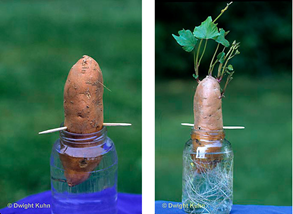
Close
Underground Stems
Blubs, stem tubers, and rhizomes are all examples of underground stems.

An onion is an example of a bulb. A bulb is a short, thick underground stem covered with closely-packed modified leaves. The leaves collect and store nutrients. When conditions are right, the bulb will split and form new daughter bulbs called lateral buds. Lateral buds will grow into a new plant that is genetically identical as the parent plant. The young plant uses the food stored in the bulb's modified leaves until it is able to make its own food.

A tuber is part of the plant structure, stem or root, which is enlarged in order to store nutrients. Stored nutrients are essential for a plant's survival, especially during winter months or when water is unavailable.
A potato is an example of a stem tuber. A stem grows from the top of the tuber, and roots grow from the bottom of the tuber. Lateral buds grow from the "eyes" or nodes of the potato. Lateral buds grow into new potato plants that are genetically identical to the parent plant.

Rhizomes are underground stems that grow horizontally just below the surface of the soil. Like other underground stems, rhizomes store food for the plant. Ginger is an example of a rhizome. Leaves grow from the upper surface of the rhizomes and roots from the lower surface. Buds form along the rhizome and grow into new plants.
Close
Runners

Runners, or stolons, are specialized stems that grow horizontally along the ground. The runner extends from the main plant, and buds form along the runner. When the bud comes in contact with the ground, it takes root and a new plant is formed. Strawberries, ivy, and some grasses are examples of plants that reproduce asexually by runners.
Close
Roots

There are two ways in which the root systems enables a plant to reproduce asexually: suckers and root tubers.
Plants, such as the chrysanthemum, aspen tree, and mint can reproduce asexually by root suckers. Roots running horizontally under the ground send out shoots called suckers. New stems grow from the suckers and break through the soil forming the new plant.

Sweet potatoes, beets, and turnips are examples of root tubers. Like stem tubers, root tubers store nutrients for the plant. Since sweet potatoes are roots and not stems, there are no nodes or buds. If a sweet potato is placed in a moist environment, new shoots will grow from the root itself and form a new plant.
Close
Leaves

Some plants reproduce asexually by the leaf. Leaves of the Bryophyllum plant, commonly called the Mexican Hat Plant, form notches located along the edges of the leaf. The buds develop into small plantlets. When the leaves fall and come in contact with moist soil, the plantlets develop into new plants.
Close
Artificial Methods

All other forms of vegetative reproduction discussed in this section happen naturally. There are also forms of artificial vegetative reproduction. The most common artificial methods include cutting, grafting, and layering.
Vegetative reproduction from cutting involves taking part of the stem from the parent plant with the leaves still attached and placing it in moist soil or water. Once the stem is in moist soil or water, new roots will begin to develop. The stem will develop into a new plant identical to the parent plant. Plants such as sugar cane and ivy can be reproduced from cuttings.

Grafting involves taking a small branch of a plant and attaching it to another plant. Both plants are cut at an angle and placed so that the cut ends have contact with each other. The cut ends are held together using string or tape. The vascular tissue of the two plants will grow and fuse together. The original plant is called the stock plant, and the plant that is attached to the stock plant is called the scion.

Layering is another method of artificial vegetative reproduction. In layering, a stem that is still attached to the parent plant is bent towards the ground covered with soil. Roots will begin to develop in the area the branch is in contact with the soil. After the roots have developed, the new plant, which is genetically identical to the parent plant, can be removed and planted in a separate location. This method of vegetative reproduction is mainly used for plants with flexible branches, such as shrubs.










